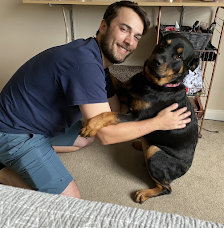Stand Tall and Proud! (Importance of Posture)
Today we are going to be looking at posture and body mechanics! Pictured above are three of my most favorite people, my closest friend, Cat, my boyfriend, Jack, and my sister, Hannah. As you can see they all are performing distinct positions but lets focus on one picture to examine- the one of Jack and my doggo, Storm, in the center!
Jack is leaning forward to hug Storm, putting his pelvis in an anterior tilt. As far as his vertebral column, it is performing a great amount of flexion in the sagittal plane, producing an exaggerated spinal curve in mostly in the thoracic vertebrae and cervical vertebrae, with slight flexion in the lumbar. His right and left femur are both laterally abducted for him to balance out his center of gravity with equal weight distribution. As you can see Jack is reaching out in-front of him to hold my dog, this means his shoulders at the glenohumeral joint are flexed, while the scapulae are protracted at the scapulothoracic joints. His head is rotated to the side, primarily in a neutral position in relation to his spine, but there may be in a small amount extension for him to pose for the photo.
This position overall is not ideal body positioning, with obvious poor alignment of the spine. To take his stability into account, let's imagine I walked up to him and shoved him at the shoulder. There would be a good chance he would fall over/struggle to stay up, because he is not securely sitting on his pelvis, instead solely relying on his core to keep him positioned. In order to change his position to stand and increase mobility, it would take good effort. He is putting all of his weight on his knee joint, (ouch!), instead of aligning his feet underneath him as someone would be doing while sitting in a chair preparing to stand. So instead of popping right up to stand, he would have to position a leg out in-front of him, like in a kneel position, to stand, which may be a challenge for some individuals. His base of support is fairly large, including the entire area of contact of both LE's and the ground, between the LE's, and also the area of contact where Jack's hand is on Storm/her paw is resting on him. The resting of his hands is providing him support within this position, but if he wanted to he could freely move his arms only with the support of his trunk.
I believe pain would begin to set in after 15/20 minutes within this position, especially because of the spine flexion and pressure on the knee joints. If the spine was in a good posture the position could be held longer, with 5/10 minute intervals in-between to take weight off of the knee joints.
One of the main reasons to avoid poor position and faulty body mechanics to prevent back pain. Back pain is SUCH a common issue and effects our overall health and functional mobility tremendously. When your back is hurting, you feel much less motivated to do daily activities, not to mention the other structures of the body that can be compromised because of back pain. It is important to also keep in mind that our posture gives off non-verbal communication. It can effect the way that other's view you, especially within the workplace. A "slouching back" can often be associated with someone who is insecure or unmotivated.
Wolff's law states that, your bones will adapt based on the stress or demands placed on them. therefore, keeping awareness of our posture can change our bone formation forever.
Educating clients on this information like Wolff's law can help them better recognize why it is so important to maintain positioning. Interventions can be shaped specifically around client's occupation, but include how to lift/manipulate heavy or awkward objects to avoid straining the back (different forms for lifting), how to maintain aligned posture during a standing job (shifting body weight) or a sitting job (the use of ergonomics chairs, pillows, towels for support). Teaching the client on how they can be aware of posture as well as the importance of stretching can promote a healthy posture even on their days not seeing an OT.
Thanks for reading & remember to stand up straight. 😊




Comments
Post a Comment